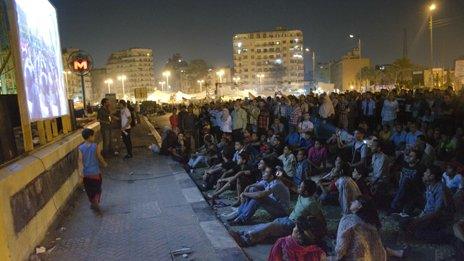Egypt's activists use film to move beyond Tahrir Square
- Published

Across Egypt, activists opposed to the country's military regime are busy turning public squares, neighbourhood cafes and street corners into makeshift cinemas.
Armed with projectors, speakers, and bed-sheets for screens, they set up impromptu screenings in areas far from their spiritual home of Tahrir Square, attracting crowds of curious locals with footage of beatings and killings at the hands of the Egyptian army, largely ignored by state-run television channels.
It is all the work of a growing activist campaign known as "Kazeboon" - or "Liars" - a loose collection of activists determined to expose what they say is the dishonesty and brutality of Egypt's Supreme Council of the Armed Forces (Scaf), which took over from President Hosni Mubarak a year ago, and is yet to transfer power to a civilian administration.
"The purpose of the Kazeboon campaign is to expose the lies being spread by Scaf and to show people the truth of what is happening in their country," says Salma Said, one the activists involved in the screenings.
"It's very important to reach the people outside Tahrir Square," she adds.
"Most of the people who come to Tahrir already know what is going on there. We need to reach the people who don't know, and are getting their information from Scaf-controlled state media."
Guidelines
Ms Said is a founding member of a film collective known as "Mosireen", or "The Insistent", which spends hours filming and archiving protest footage, uploading videos to YouTube and distributing DVDs to be played at Kazeboon screenings.
Their films combine footage of army abuses with testimonies of protesters and documentaries about some of the "martyrs" killed during Egypt's revolution.
The collective first started showing footage of protests on big screens in Tahrir Square in July.
But the campaign began to snowball after the army denied responsibility for the deaths of dozens of protesters in bloody clashes outside Cairo's state television building in October.
"We started providing guidelines on how to set up screenings and producing DVDs with our films on them," explains Ms Said. "After that people just started doing it on their own in all neighbourhoods of the city."
With no co-ordinators or hierarchy to the Kazeboon campaign, it is difficult to keep track of the number of screenings now taking place, but an online calendar of events used by Egyptian activists suggests dozens are happening across the country every day.
Meanwhile, the Mosireen collective's YouTube channel, where it posts increasingly sophisticated and produced films about the protest movement, has seen its popularity explode, becoming the most viewed non-profit channel in the world in January, and Egypt's most viewed non-profit channel of all time.
This, the collective's founders say, is the new frontier in Egypt's revolution.
Local credibility
Its success reflects widespread and growing discontent with the ruling military council in Egypt, and its head, Field Marshal Mohammed Hussein Tantawi.
Once seen as the saviours of the revolution, the army generals are increasingly accused of trying to stall the transition to civilian power to protect their own interests, while repressing and killing protesters they portray as thugs, criminals or even foreign spies.
Dr Rasha Abdulla, professor of journalism and mass communication at the American University in Cairo, says the Kazeboon campaign has been not only important in exposing atrocities committed by security forces, but also in helping restore the credibility of Tahrir Square activists in the eyes of other Egyptians.
"There has been a consistent effort [by the regime] to discredit undermine and distort the image of everyone who supports the Tahrir Square protests," she says.
"The Kazeboon campaign means you are able to reach as many people as possible and show that you're not thugs."
"As the screenings are typically organised by locals, it gives it more credibility among the neighbourhood residents," Dr Abdulla adds.
Re-engaging with people outside of Tahrir Square is seen as crucial to a protest movement that has struggled to compete politically with the Muslim Brotherhood, which has spent decades investing time and money in local communities.
The Kazeboon screenings are frequently followed by marches through the local neighbourhoods, where local activists try to appeal to locals with chants of "Down with military rule".
Complaints
The reaction has not always been positive, however.
Several screenings have been broken up with violence after locals objected to activists arriving on their doorsteps.
In the upmarket Cairo district of Zamalek, which sits on an island in the middle of the Nile, organisers were accused of trying to "bring bloody Tahrir to our peaceful island".
Despite those difficulties the Kazeboon campaign shows no signs of slowing, and is gaining support among the protesters still determined to camp in Tahrir Square until the military council gives up power.
"Protesting and sleeping here all the time is taking a lot of energy," says Ali Asem, a member of the influential 6 April activist movement, sitting outside his tent in one corner of Tahrir Square.
"Now we need to take to the streets instead, to gather more people and let them know what we are thinking."
Edwin Lane is an independent journalist and Middle East specialist